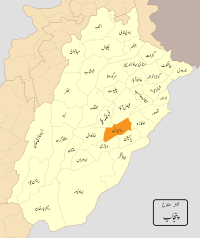Montgomery (Pakistan)
|
Sahiwal District ضِلع ساہِيوال Montgomery District |
|
|---|---|
| District | |
 Location of Sahiwal in Punjab. |
|
| Country | Pakistan |
| Province | Punjab |
| Headquarters | Sahiwal |
| Area | |
| • Total | 3,201 km2 (1,236 sq mi) |
| Population (1998) | |
| • Total | 1,843,194 |
| Time zone | PST (UTC+5) |
| Website | www.sahiwal.gov.pk |
Sahiwal District (Urdu: ضِلع ساہِيوال), is a district in the Punjab province of Pakistan. In 1998, it had a population of 1,843,194 people, 16.27% of which were in urban areas. Since 2008, Sahiwal District, Okara District, and Pakpattan District have comprised the Sahiwal Division. The city of Sahiwal is the capital of the district and the division.
The Sahiwal District has been settled from the pre-historical era. Harappa is an archaeological site, about 35 km (22 mi) west of Sahiwal, that was built approximately 2600 BCE. The area was part of South Asian empires and in crossroads of migrations and invasions from Central Asia.
Sahiwal District was an agricultural region with forests during the Indus Valley Civilization. The Vedic period is characterized by Indo-Aryan culture that invaded from Central Asia and settled in Punjab region. The Kambojas, Daradas, Kaikayas, Madras, Pauravas, Yaudheyas, Malavas and Kurus invaded, settled and ruled ancient Punjab region. After overrunning the Achaemenid Empire in 331 BCE, Alexander marched into present-day Punjab region with an army of 50,000. The Sahiwal was ruled by Maurya Empire, Indo-Greek kingdom, Kushan Empire, Gupta Empire, White Huns, Kushano-Hephthalites and Shahi kingdoms. From the beginning of the 7th century Rajput kingdoms dominated Eastern portions of Pakistan and northern India. In 997 CE, Sultan Mahmud Ghaznavi, took over the Ghaznavid dynasty empire established by his father, Sultan Sebuktegin, In 1005 he conquered the Shahis in Kabul in 1005, and followed it by the conquests of some western Punjab region. Eastern Regions of Punjab from Multan to the Rawalpindi in north (Including region of present-day Sahiwal) remained under Rajput rule until 1193. The Delhi Sultanate and Mughal Empire later ruled the region. The Punjab region became predominantly Muslim due to missionary Sufi saints whose dargahs dot the landscape of Punjab region.
...
Wikipedia
